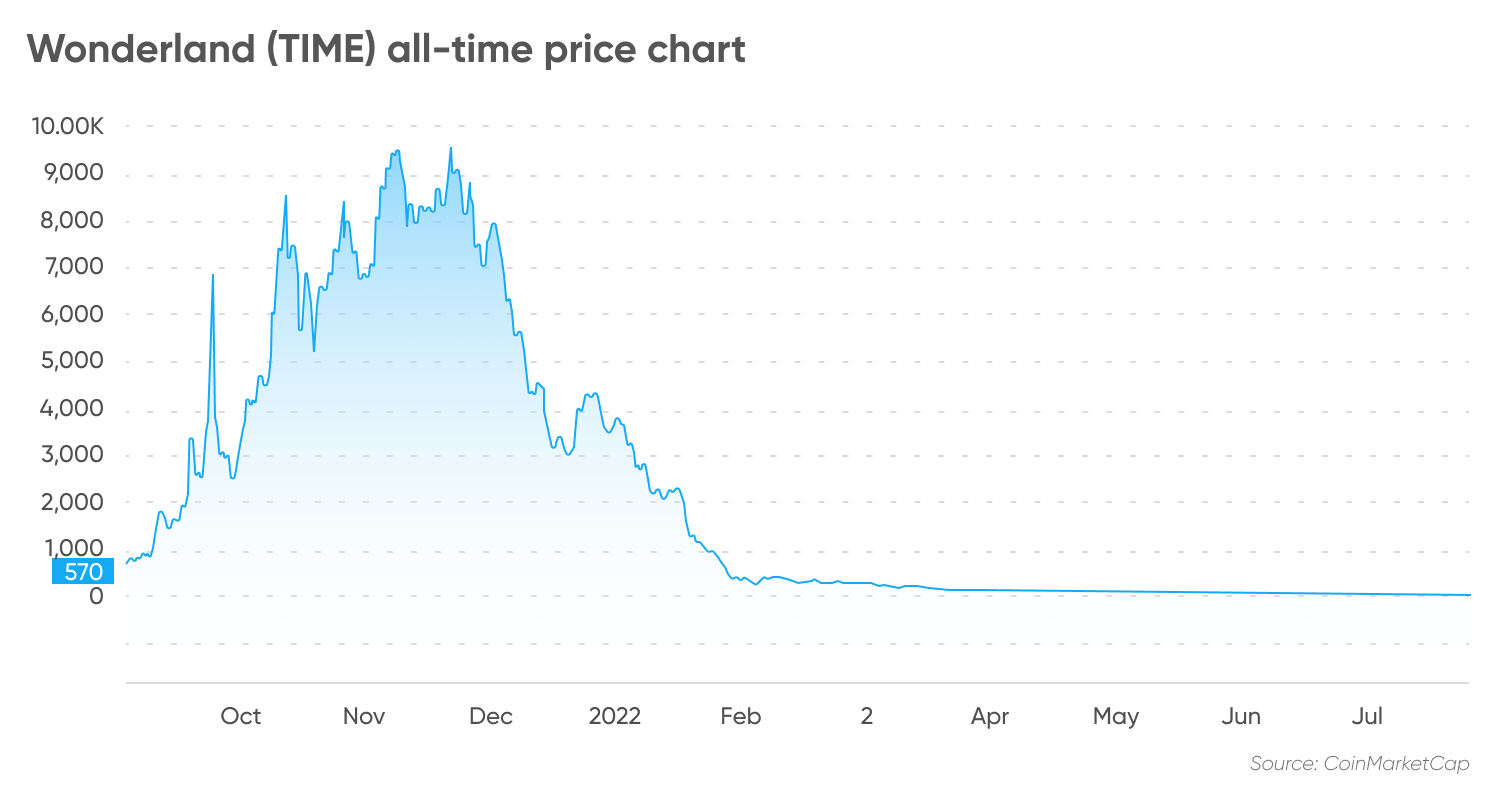Wonderland price prediction: Can TIME recover?
TIME has been rallying after Wonderland integrated the new Avalanche staking testnet
For a coin that briefly topped $14,000 last November, TIME – the coin of troubled decentralised reserve currency protocol Wonderland – has been plunged into trouble this year, losing over 99% of its value in 2022
In January, the company was rocked by news service Bloomberg revealing that its treasury head was Michael Petryna, a convicted felon with ties to one of the biggest cryptocurrency scandals, the failed Canadian crypto exchange QuadrigaCX.
As well as raising questions over the future of Wonderland, the revelation also energised the debate over the wider issue of the governance of decentralised finance (DeFi) projects.
Petryna has since left the organisation and is reported to have set up a new crypto under his old handle of 0xSifu. Wonderland’s co-founder has also resigned from his position as advisor and treasury manager.
As of 15 September 2022, TIME was up 8% over the past week, following its integration with the Avalanche liquidity staking testnet.
So what is Wonderland (TIME)? Why has the market fallen out of love with it so dramatically? What is the outlook now, and what is a realistic target price?
In this article we examine the analysis of the forecasters and their TIME coin price predictions, and review the latest Wonderland cryptocurrency news, to help you set expectations should you decide to make the coin part of your portfolio.
Wonderland offers high returns on staking
Wonderland is a decentralised reserve currency protocol, and one of the first Olympus forks on the Avalanche blockchain network. Its TIME cryptocurrency token is backed by a treasury of liquidity tokens, including Magic Internet Money (MIM). The MIM token is native to the Ethereum blockchain and bridged to Avalanche.
“Because the treasury backs every TIME with at least 1 MIM, the protocol would buy back and burn TIME when it trades below 1 MIM. This has the effect of pushing TIME price back up to 1 MIM. TIME could always trade above 1 MIM because there is no upper limit imposed by the protocol,” according to the company’s documentation.
“We believe that the actual price will always be 1 MIM + premium, but in the end that is up to the market to decide.”
Holders of TIME tokens can stake them to receive more tokens in return, or they can mine them by providing liquidity pool tokens or MIM tokens in exchange for receiving TIME at a discount after a fixed period.
Wonderland’s history
Wonderland was launched in September 2021 by Web3 developer Daniele Sesta and an anonymous team from the decentralised finance (DeFi) community. They adopted a decentralised autonomous organisation (DAO) model, so governance decisions about the development of the protocol are made by token holders.
Sesta also founded Abracadabra Money, which allows users to take out loans of MIM by depositing interest-bearing collateral.
Over the long term, the developers aim to use the system to optimise TIME for stability and consistency, so that it can function as a global medium of exchange and unit of account. In the short term, they intend to optimise it for wealth creation and growth.
In October 2021, an AVAX-TIME yield farm opened on the Pangolin exchange and TIME went live on the Fantom chain, enabling users to buy staked TIME in the form of wMEMO tokens.
On 12 December 2021, the governance framework was set out in a blog post.
On 6 January 2022, the DAO announced an investment in Betswap.gg, a decentralised cryptocurrency betting platform. The investment was Wonderland’s first at the seed stage of a new project. The DAO invested $18.34m, in return for 2.096 billion BSGG tokens.
Sesta tweeted in October that Wonderland would soon have a launchpad for creating and funding DAOs “using the full Olympus DAO model/token economics to distribute and raise funds”.
TIME price retreats from rapid rally
As shown by the chart below, the TIME token soared in value from $554 on 2 September 2021, rising to a peak of $9,993 on 8 November. It retreated to $7,447 on 10 November but breached $9,000 again on 17 November 2021, reaching a high of $9,856 before it began to decline.
TIME dropped to a low of $2,757 on 14 December 2021, and ended the year at $3,733, for a 574% gain from the launch. But the price chart shows it experienced a steep decline in the first quarter of 2022. This came after controversy hit the DeFi protocol.
0xSifu, an anonymous DAO member described as Sesta’s right-hand man, was identified in January as Michael Patryn. Patryn is a convicted criminal who has pled guilty to numerous crimes, including computer fraud and grand larceny.
Sesta revealed that he knew Patryn’s identity and had decided to work with him anyway. After this tweet, the price of TIME plummeted, which even resulted in Sesta hosting a community vote to end the project. While the proposal did not pass, Wonderland’s price still faced consequences. TIME plunged to $9.02 on 19 August 2022.
However, it has gained almost 50% over the past seven days as the community has been voting on various proposals, including a formal inquiry into Sesta after 13 different concerns were raised during an ‘ask me anything’ (AMA) session on 24 August 2022.
The proposal said: “As these responses are not adequate to resolve the concerns and additional concerns still linger, we believe the next best course of action is to involve the DAO in this process for complete transparency.”
On 4 September 2022, Sesta announced his resignation as Wonderland’s interim treasury manager and advisor.
In response, the DAO said: “The community has been working together diligently to lay the foundations for the road ahead. Much of our work over the last few months has been to increase security and operational stability for the protocol. We continue this effort together, with new proposals opening for DAO Discussion on the forum.”
As of 15 September 2022, TIME was trading at $14.70. This price comes after Wonderland successfully integrated the Avalanche (AVAX) Liquid Staking Testnet
But is there any hope for the TIME cryptocurrency? Let’s look at some of the latest projections.

Wonderland price prediction: Will TIME rally or decline in the future?
From the short-term perspective, technical analysis from CoinCodex showed that sentiment was bearish at the time of writing (15 September). There were 20 indicators showing bearish signals while just five were bullish.
In its short-term Wonderland crypto price prediction, CoinCodex suggested that the value of the Wonderland token could have fallen to $10.61 by 14 October.
The Wonderland coin price prediction from algorithm-based forecasting site WalletInvestor was very bearish, predicting the TIME price could fall to $2.25 in a year’s time and $1.22 by the beginning of 2027
The TIME crypto price prediction from DigitalCoinPrice was much less bearish, projecting that TIME could gain in value over the next few years. DigitalCoinPrice’s Wonderland price prediction for 2022 expected it to average out at $19.51.
TIME was expected to climb to $59.25 in 2025, while the site’s Wonderland price prediction for 2030 suggested a maximum price of $208.39.
PricePrediction’s long-term Wonderland TIME crypto price prediction had the coin averaging $13.75 in 2022. Its Wonderland price prediction for 2025 suggested it could climb to $43.85. Based on deep artificial intelligence-assisted technical analysis, its Wonderland prediction suggested it could soar to an average of $252.76 by 2030
When considering a TIME price prediction, it’s important to keep in mind that cryptocurrency markets remain extremely volatile, making it difficult to accurately predict what a coin or token’s price will be in a few hours, and even harder to give long-term estimates. As such, analysts and algorithm-based forecasters can and do get their predictions wrong.
If you are considering investing in cryptocurrency tokens, we recommend that you always do your own research. Look at the latest market trends, news, technical and fundamental analysis, and expert opinion before making any investment decision. Keep in mind that past performance is no guarantee of future returns, and never trade with money that you cannot afford to lose.
FAQs
Is Wonderland a good investment?
TIME has been the centre of many controversies this year, which kicked off after the revelation that convicted criminal Michael Petryna was a key community member. This fuelled a crash in Wonderland’s price.
Cryptocurrencies are highly volatile assets, making them high-risk investments, especially newer coins like TIME. Whether TIME could be an appropriate investment for your portfolio depends on your personal circumstances and risk tolerance.
You should evaluate the level of risk you are prepared to accept before investing, and never invest money that you cannot afford to lose.
Will Wonderland go up or down?
No one can say for sure. As of 15 September 2022, forecasters were mixed in their future TIME price predictions. PricePrediction projected the price could rise in the next few years, while WalletInvestor believed the price could fall below $2 by the end of 2023.
In volatile cryptocurrency markets, it is important to do your own research on a coin or token to determine if it is a good fit for your investment portfolio. Whether TIME is a suitable investment for you depends on your risk tolerance and how much you intend to invest, among other factors.
Keep in mind that past performance is no guarantee of future returns, and never invest money that you cannot afford to lose.
Should I invest in Wonderland?
Wonderland has lost over 99% of its value in 2022, after becoming the centre of numerous controversies. It has been rallying recently, however, as the community is voting on whether a formal inquiry is required into the DeFi protocol’s founder.
Whether you should invest in Wonderland is a question that you will have to answer for yourself. Before you do so, however, you will need to conduct your own research. Never invest more money than you can afford to lose, because prices can go down as well as up.